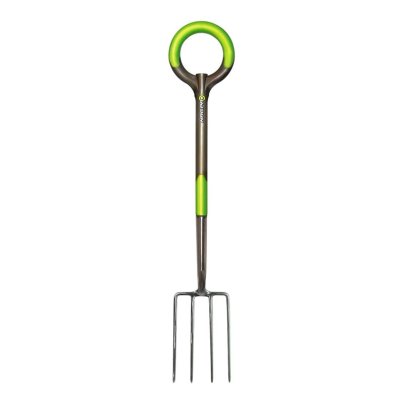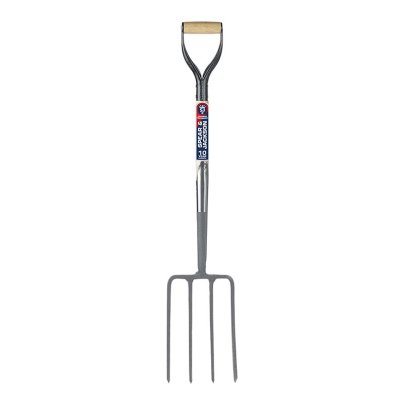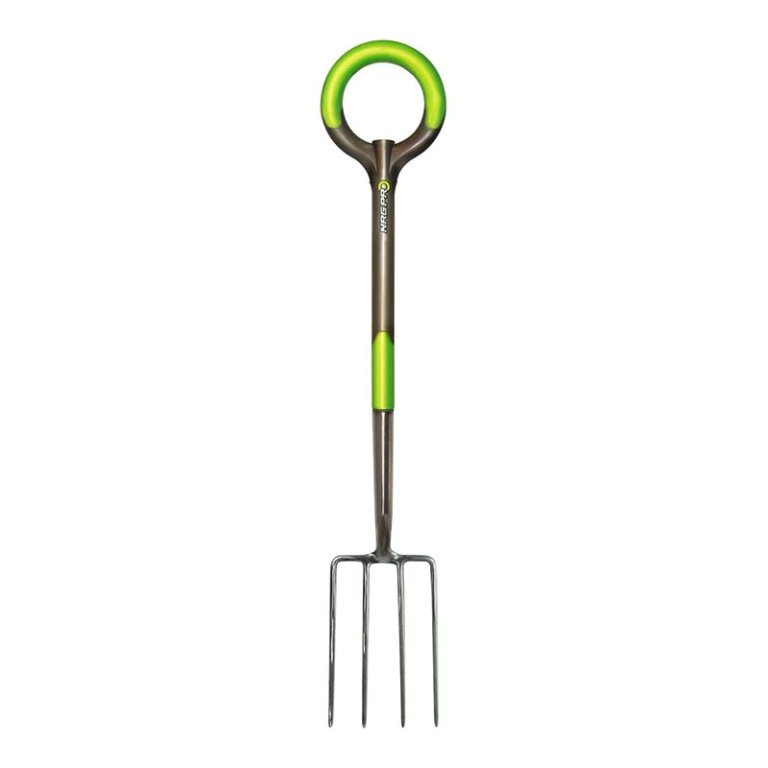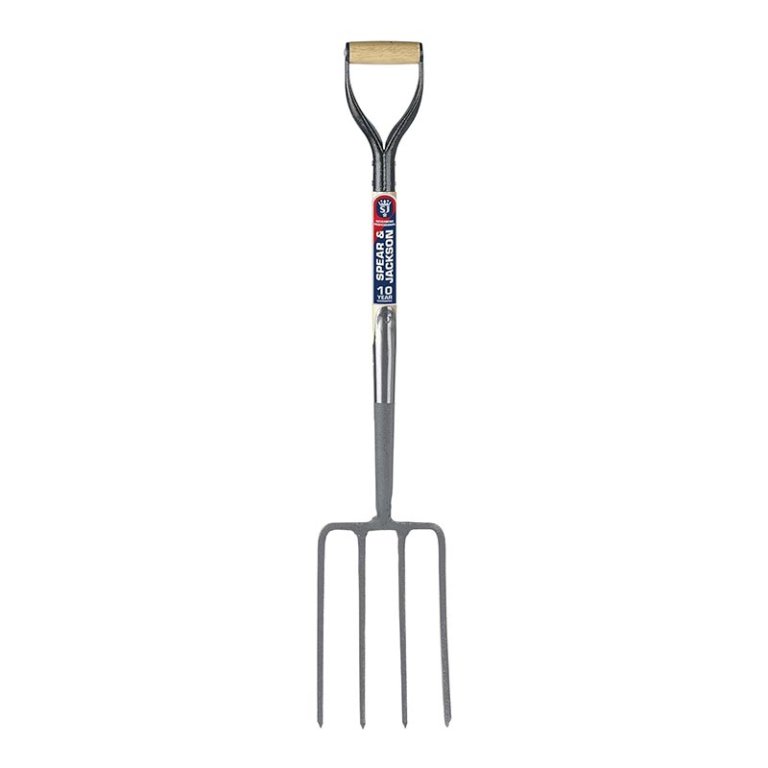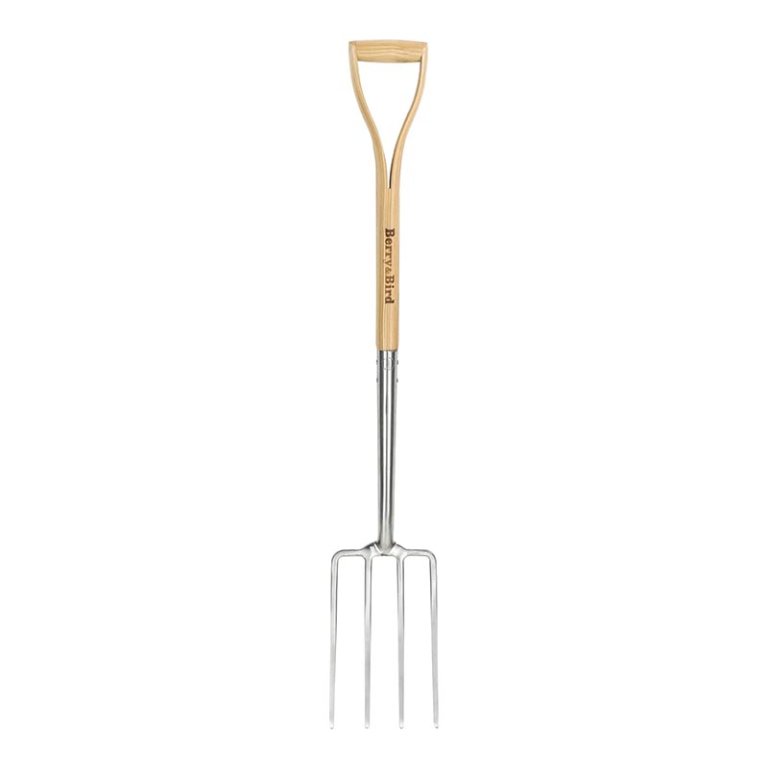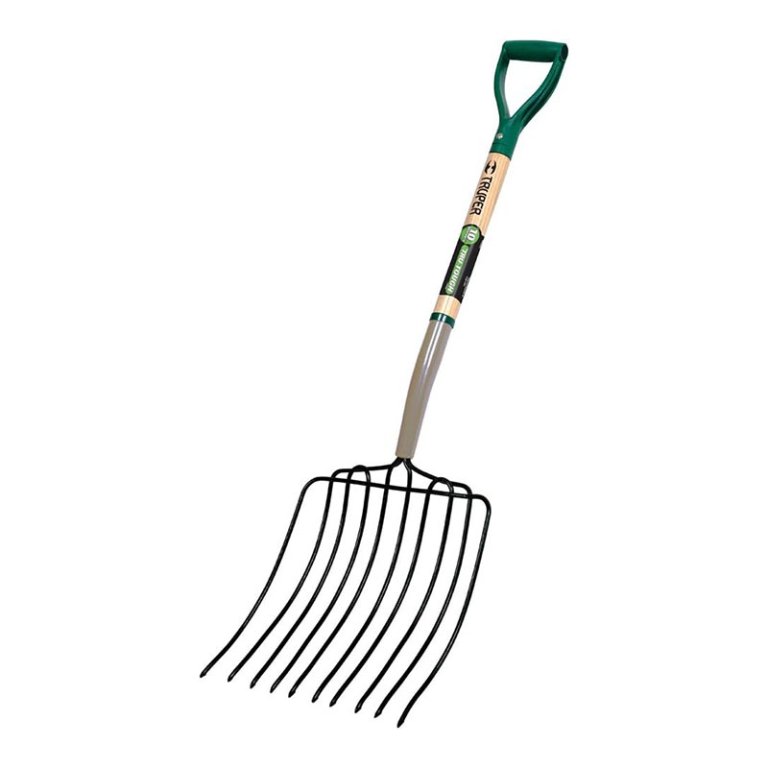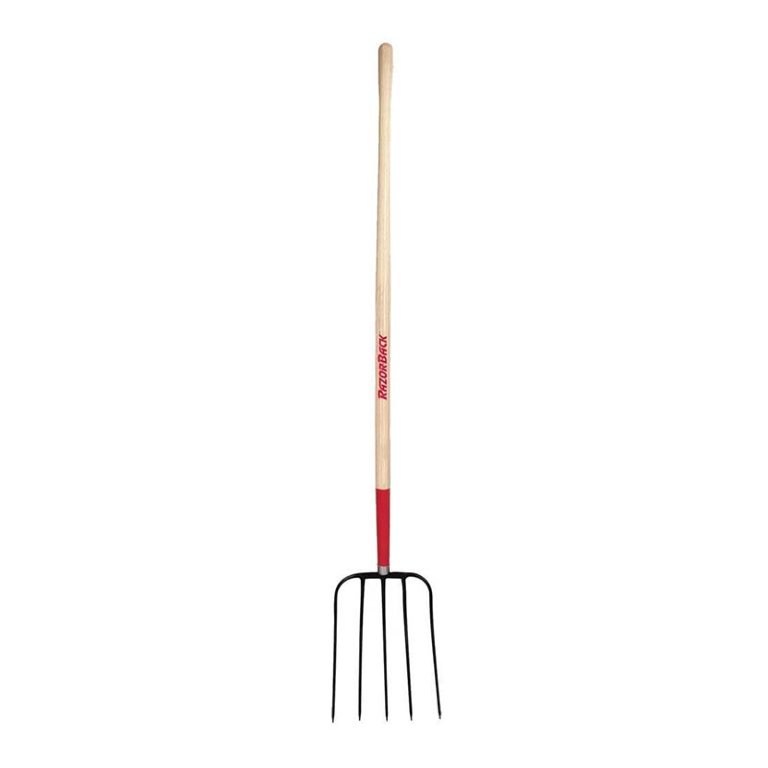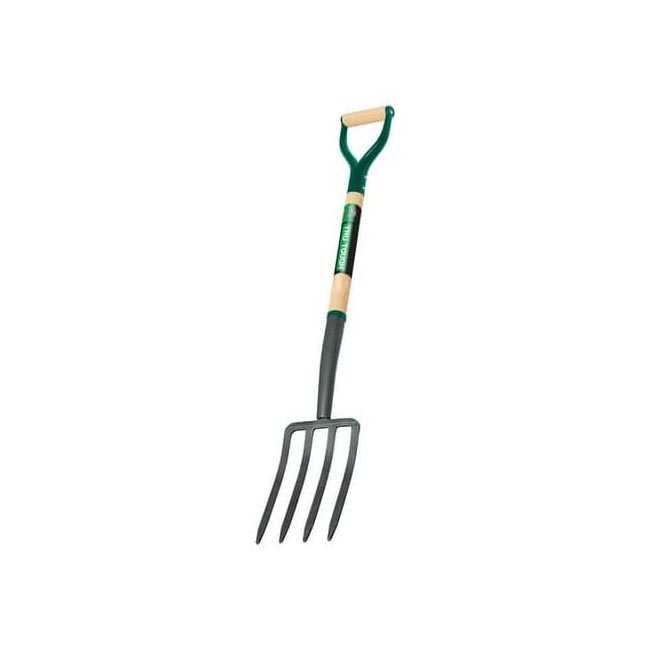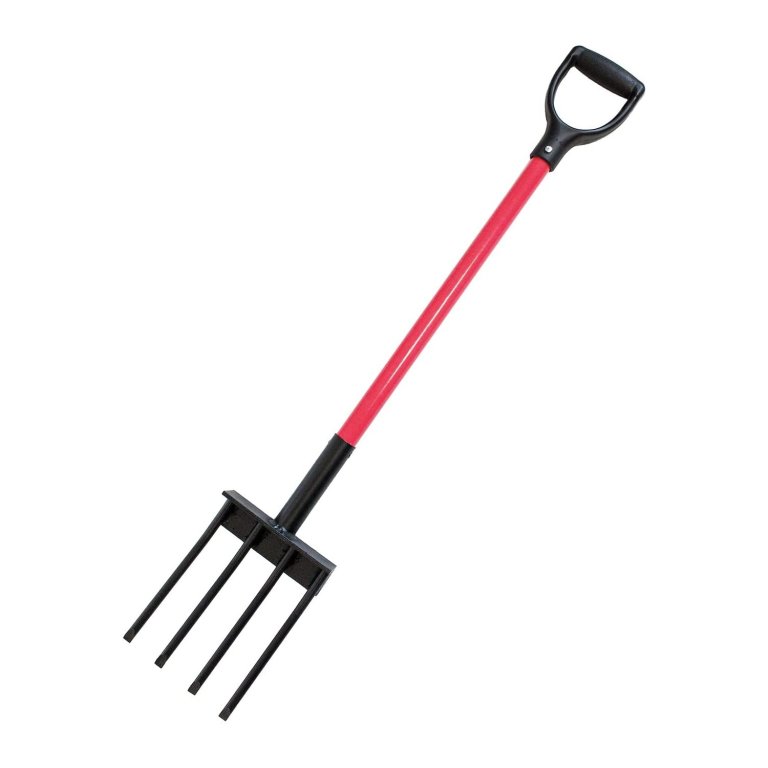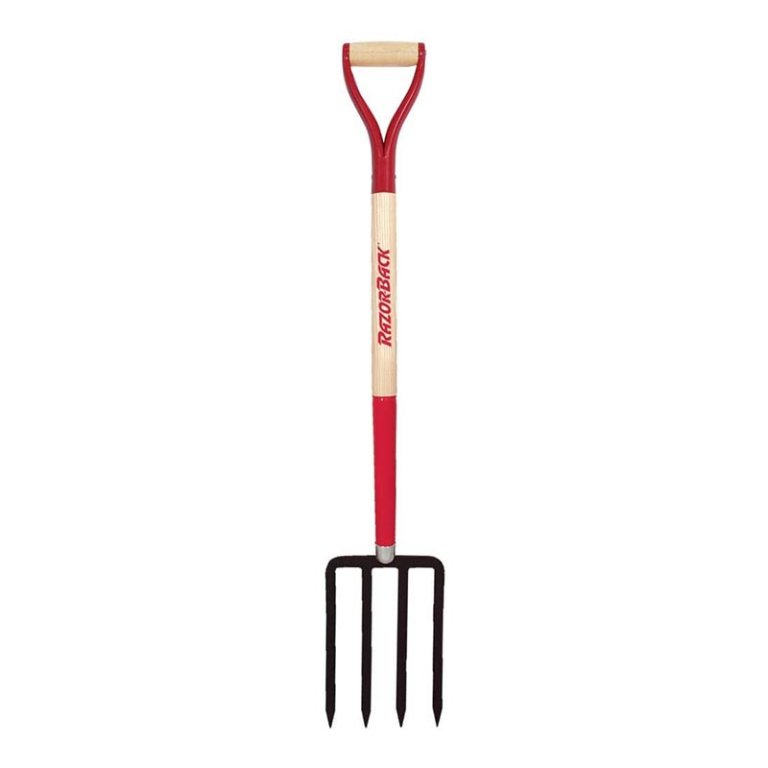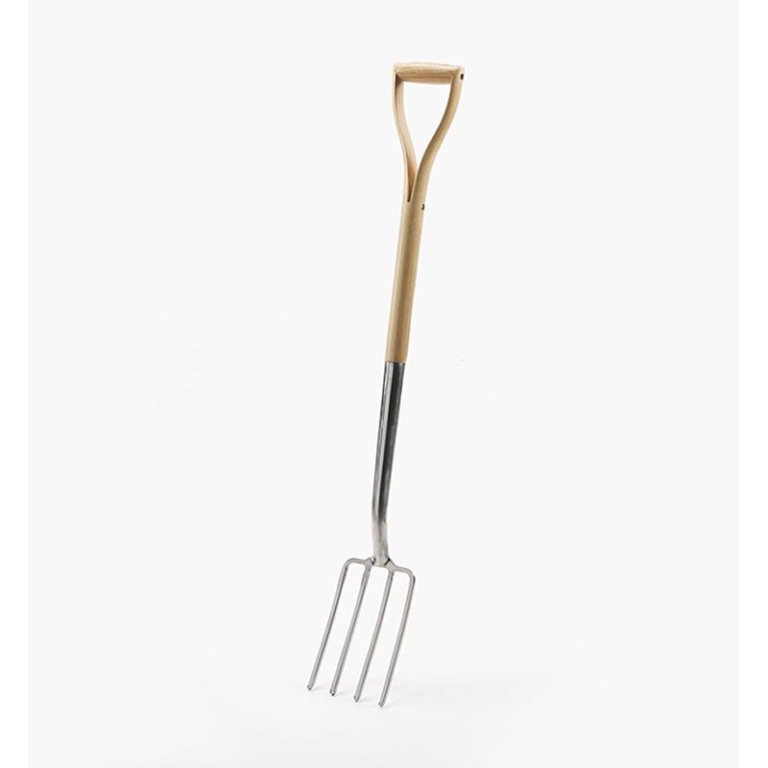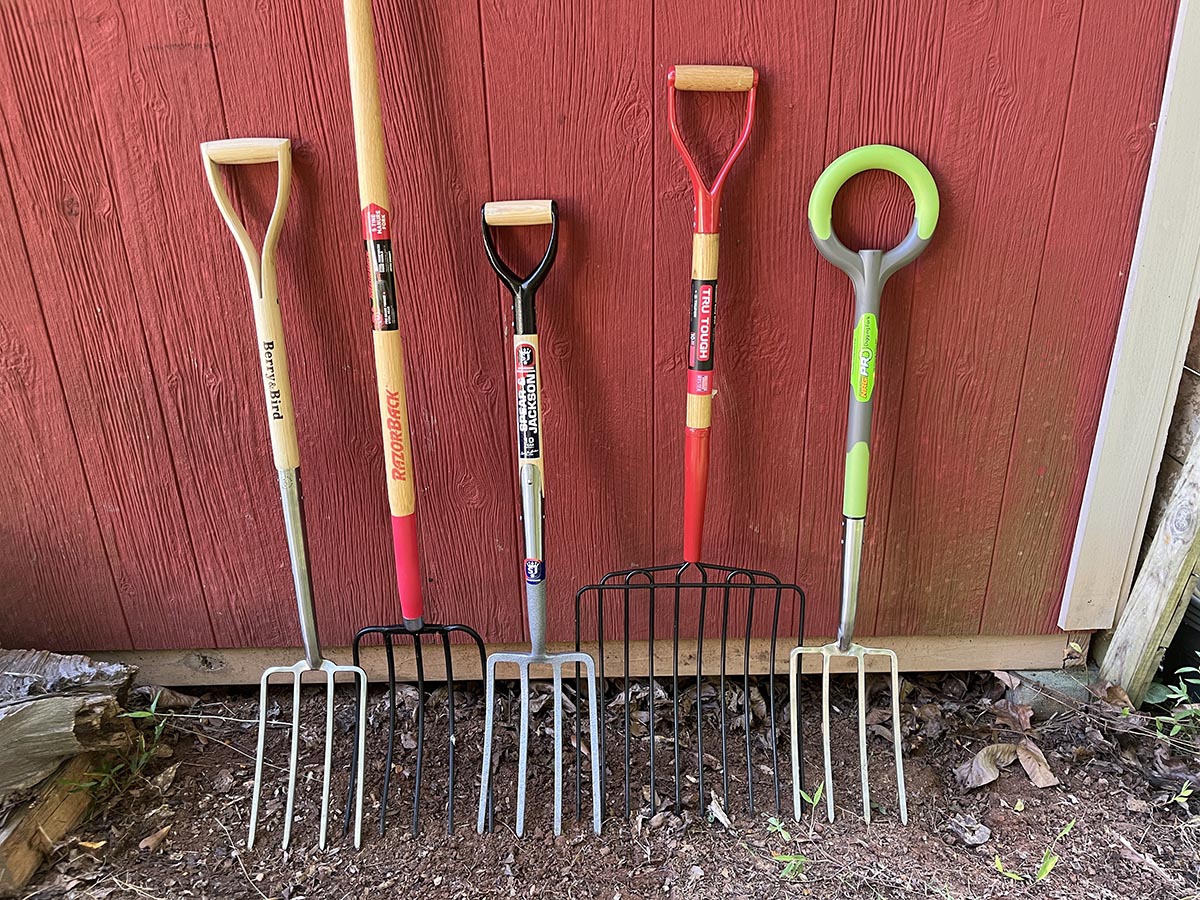
We may earn revenue from the products available on this page and participate in affiliate programs. Learn More ›
Whether you need to break up garden soil, spread mulch, or turn compost, the right pitchfork can help. The word “pitchfork,” originally used to describe a tool for tossing animal feed, bedding, or manure, has come to include all kinds of farm and garden forks. With so many different types to sort through, finding the right kind for the task at hand is sometimes challenging. To help cut through the confusion, we spent 10 hours testing five pitchforks representing three of the most-often used types.
Since home gardeners are typically looking for a quality soil fork, that was the type we selected as our top choice. Our favorite, though, was the Berry & Bird spading fork. Although it was a bit more expensive, we especially loved the retro styling and its incredibly durable stainless steel head. The hardwood D-handle felt great in hand, and the deep socket allowed us to apply tons of leverage without breaking the handle. With that being said, however, that fork won’t do the job if you are trying to spread mulch or turn a compost pile.
In this guide we will offer our observations on these garden-tested tools, as well as a few popular alternatives that we haven’t put our hands on quite yet. Read on for all you need to know in order to pick out the best pitchforks for all your gardening needs.
- BEST OVERALL: Radius Garden 203 Pro Stainless Digging Fork
↓ Jump to Review - BEST BANG FOR THE BUCK: Spear & Jackson Neverbend Professional Digging Fork
↓ Jump to Review - BEST FOR DIGGING: Berry & Bird 4-Tine Stainless Steel Spading Fork
↓ Jump to Review - BEST FOR MULCH: Truper Tru Tough Manure/Bedding Fork
↓ Jump to Review - BEST FOR COMPOST: Razor-Back 5-Tine Forged Manure Fork
↓ Jump to Review - BEST LIGHTWEIGHT: Truper Tru Tough Spading Fork
↓ Jump to Review - MOST DURABLE: Bully Tools Spading Fork With Fiberglass Handle
↓ Jump to Review - BEST FERRULE: Razor-Back 4-Tine Digging Fork
↓ Jump to Review - BEST BORDER FORK: Lee Valley Border Fork
↓ Jump to Review

| Testing Stats | |
| Products tested | 5 |
| Time spent testing | 10 hours |
| Tests performed | 4 |
| Price range | $30 to $70 |
Our Top Picks
In our backyard tests, we learned a lot about the finer points that can make or break a gardening tool. Choosing the right fork for the job is key. Whatever sort of pitchfork you may need, this list is sure to have you covered.
Best Overall
Radius Garden 203 Pro Stainless Digging Fork
What We Like
- Ergonomic loop handle
- Durable stainless steel tines
- Weatherproof poly-coated steel handle
- Good height for most users
What We Don’t Like
- Tubular steel handle might bend with excessive leverage
Product Specs
- Type: Digging
- Length: 42.5 inches
- Weight: 5 pounds 2 ounces
Our Ratings: Ergonomics 5/5; Performance 4/5; Durability 5/5; Value 5/5
With its strength, durability, and ergonomics, the Radius Garden 203 Pro stainless steel digging fork is a complete digging tool. Its unique appearance, highlighted by an outsized loop handle, comes out of the “form follows function” principle. The loop handle offers an easy grip for all hand sizes, with or without gloves. At 42.5 inches overall, the tool height accommodates most users without excessive bending. The colorful polypropylene and thermoplastic exterior provides weatherproof protection for the strong carbon steel shaft, as well as a grippy surface for the user. This tool is built for many years of dependable, comfortable use.
The Radius Garden digging fork excelled throughout our in-garden tests. Weighing in at 5 pounds 2 ounces, it was one of the heaviest of the group. In most digging applications, the extra weight was more help than hindrance, as it pushed the tines downward more efficiently. The square steel tines did a great job shedding the sticky clay soil and breaking up clumps. Our only concern was about the tubular steel shaft potentially bending under leverage, since the handle is not replaceable. That being said, it held up to our 10-second, 130-pound leverage test.
Ergonomics was the difference maker with this tool, and it’s the reason we selected it as our top pick. Although traditionalists may shun the modern look and materials, this tool worked extremely well in the garden.
Get the Radius Garden pitchfork at Amazon, The Home Depot, or Walmart.
Best Bang for the Buck
Spear & Jackson Neverbend Professional Digging Fork
What We Like
- Powder-coated forged carbon steel head
- Hardwood D-type handle
- Excellent strength-to-weight ratio
- Value price point
What We Don’t Like
- Less comfortable for taller users
Product Specs
- Type: Digging fork
- Length: 39 inches
- Weight: 5 pounds 1 ounce
Our Ratings: Ergonomics 4/5; Performance 4.5/5; Durability 5/5; Value 5/5
Those who are searching for a heavy-duty garden fork that can reliably break up tough soil without breaking the bank will find the Spear & Jackson Neverbend digging fork up to the task. The forged steel fork head features rugged square-profile tines and a long lipped socket. The upper parts include a 29-inch weatherproof hardwood shaft and a D-handle. The hammer-finished powder-coated steel head allows minimal soil adhesion, while the short length and tall socket accommodate heavy leverage.
Our test garden’s clay soil presented no problem for the Spear & Jackson Neverbend digging fork. The tines easily penetrated the compacted soil to maximum depth, and as the name claims, the stout handle and riveted connections held up to hard work without bending, cracking, or loosening. We initially had some concerns about the open-back socket possibly bending or loosening with consistent heavy use, but after an hour of abuse that included forcing 130 pounds of leverage beneath a concrete slab, we were pleased to note that it held firm.
A few important details to note are the feel of the grip and the overall size of the tool. On the positive side, the well-proportioned D-handle offered ample space to accommodate gloved hands. But our 6-foot-tall tester noted that the shorter tool height called for a more bent-over working posture. So, while we loved the overall design and construction of this digging fork, taller users may prefer a longer digging tool.
Get the Spear & Jackson pitchfork at Amazon.
Best for Digging
Berry & Bird 4-Tine Stainless Steel Spading Fork
What We Like
- Strong and durable but lightweight
- More comfortable for users of all sizes
- Stainless steel deep socket head
- Hardwood handle
What We Don’t Like
- Hardwood can be less durable than other materials
Product Specs
- Type: Digging fork
- Length: 44 inches
- Weight: 6 pounds 4 ounces
Our Ratings: Ergonomics 5/5; Performance 4.5/5; Durability 5/5; Value 4.7/5
If you prefer the traditional look and natural feel of a hardwood handle with the durability of a stainless steel head, the Berry & Bird spading fork could be the perfect tool. Weighing just 6 pounds 4 ounces, it was the lightest pitchfork we tested, but its sturdy handle and deep socket design give it the durability required of daily-use gardening tools. The fork head measures 11.8 inches high and 7.2 inches wide.
This steel garden fork was a pleasure to test. In normal digging situations, it felt strong and nimble enough to do it all: breaking up heavy soil, aerating the root zone around trees and shrubs, turning compost, and moving perennials for transplanting. Like the other stainless steel forks we tested, it did a great job resisting soil buildup on the tines.
In addition to its capabilities of working heavy garden soil, the lightweight build made it a better multitasker than most of the others. The 13-inch closed-back socket encased nearly half of the shaft for added support in leverage situations. It passed our 130-pound leverage test without noticeable damage to the wood or steel. For jobs like double digging and lifting, this lightweight fork was the best option among our test group.
This was our favorite of all the gardening forks we tested. The reason we didn’t award it the top spot was because of the wood handle. It comes with natural variation in wood grain that is not repeatable from tool to tool, so others’ experience may differ from ours. Also, with care it could last decades or longer, but if left exposed to the elements, it will quickly degrade.
Get the Berry & Bird pitchfork at Amazon or Berry & Bird.
Best for Mulch
Truper Tru Tough Manure/Bedding Fork
What We Like
- Long tines with a scooping curve
- 10 closely spaced tines
- Works with wet or dry mulch
- Picks up more material per scoop
What We Don’t Like
- Specialty tool with fewer garden applications
Product Specs
- Type: Manure/bedding fork
- Length: 46 inches
- Weight: 5 pounds 5 ounces
Our Ratings: Ergonomics 4/5; Performance 5/5; Durability 4/5; Value 5/5
Some chores, like mulching the garden, call for specialty tools, like a 10-tine pitchfork. The Truper Tru Tough manure/bedding fork is designed specifically for loading and moving manure, wood chips, compost, or animal bedding. It’s equipped with a wide 10-tine head, a short shaft, and a D-handle for the best combination of power and control while loading or transferring bulk materials.
This was the first actual “pitchfork” among our test group because it is used to scoop and toss a variety of coarse materials. The tines have a round profile and are about half the diameter of the square tines on digging forks. As such, it is not suited to working in the garden, so much as working on the garden. We tested it by moving a 5-cubic-yard pile of wood chips that had been delivered by a local arborist.
Unlike the long edge of a shovel, the pointed tines penetrated the wood chips easily. When they encountered the occasional unchipped stick, they flexed enough to pick it up as well. Occasionally we had to stop and clear sticks out from between the tines, which was a simple matter of dragging the back of the fork across the grass. With this fork we were able to move at a steady pace, pick up a large volume per scoop, and pitch it a few feet to fill the wheelbarrow. That’s the ideal job for this fork, and it worked perfectly.
Get the Truper manure/bedding pitchfork at Amazon, Rural King, or Do It Best.
Best for Compost
Razor-Back 5-Tine Forged Manure Fork
What We Like
- Designed for use with wet, sticky materials
- Long handle reduces bending
- Round tines resist buildup of compost
- Durable steel head and hardwood handle
What We Don’t Like
- Not as effective for dry, small aggregate materials
Product Specs
- Type: Manure fork
- Length: 66 inches
- Weight: 4 pounds 9 ounces
Our Ratings: Ergonomics 5/5; Performance 4/5; Durability 5/5; Value 5/5
The right gardening pitchfork may do its best work above the soil. When you need to work a pile of rough compost, with its varying sizes of material and sticky wet texture, a pitchfork with widely spaced tines works better. In addition to the favorable tine configuration, we preferred the long straight handle on the Razor-Back five-tine manure fork as well. The fork head features oval-profile steel tines with an upward scoop shape, attached to a 54-inch hardwood handle.
This pitchfork did fine alongside the 10-tine fork on our mulch-moving project, but it excelled when we had to turn a pile of compost. The wide tine spacing and (relatively) smaller head size allowed it to easily penetrate the dense, partially composted pile and made it easier to lift and turn. We also preferred the long, straight handle because it made it easier to get all the way to the bottom of the pile with less bending. The oval tines were also shorter than those on the 10-tine fork, so they were more rigid, which helped with the heavier material.
Having similar dimensions to a traditional hay fork, the Razor-Back manure fork was also an excellent tool for picking up piles of tall weeds and garden debris. It didn’t matter if the debris was still fresh and green or dried out after baking in the sun for a few days. For that reason, we preferred this one for all aspects of composting from start to finish.
Get the Razor-Back manure pitchfork at The Home Depot or Tractor Supply Co.
More Great Options
Want a few more options to consider? We have not tested the following pitchforks yet, but our research and verified customer feedback both indicate favorable quality and performance.
Best Lightweight
Truper Tru Tough Spading Fork
What We Like
- Smaller size, lighter weight
- Ideal for raised beds
- Easy to carry and store
- Budget-friendly price
What We Don’t Like
- Lightweight construction has more limitations
Product Specs
- Type: Spading fork
- Length: 40 inches
- Weight: 3 pounds 12 ounces
Lightweight tools are a great choice for cultivating raised beds, for smaller gardeners, or for those with limited strength and range of motion. The Truper 30293 Tru Tough spading fork weighs less than 4 pounds and measures just 40 inches long, making it one of the smallest, lightest pitchforks in our lineup. But don’t let the dimensions fool you; it’s built for real work, with a forged steel head, thick square-profile tines, and hardwood handle.
The Truper Tru Tough spading fork is an affordable and effective option for residential use, but we don’t recommend it for prying up boulders and thick roots. Use it to turn previously tilled garden soil, harvest root veggies, or aerate tree and shrub root zones. We like that it is equipped with a replaceable ferrule-style handle because the hardwood could eventually crack or otherwise wear out with extended use. This is a less heavy-duty type of construction, but it’s easier to repair than tools with socket attachments.
With all the good that this tool offers, it will not be the best choice for every user. It is a “medium- duty” tool, so those who regularly push their tools to the limit will want to opt for something with a heavy-duty build. It also comes with the caveat that it’s not a matter of “if” but “when” the handle will need to be replaced.
Get the Truper spading pitchfork at Amazon, Rural King, or DK Hardware.
Most Durable
Bully Tools Spading Fork With Fiberglass Handle
What We Like
- Fabricated steel construction
- High-strength fiberglass handle
- Wide foot plate for easier digging
- Tall height for a more upright work stance
What We Don’t Like
- Heavier; more tiring for extended work
- Fiberglass is subject to ultraviolet (UV) damage
Product Specs
- Type: Spading fork
- Length: 44 inches
- Weight: 5 pounds 5 ounces
Tired of breaking your tools? The Bully Tools spading fork is nearly indestructible. It features a heavy-duty powder-coated steel head, high-strength fiberglass handle shaft, and a molded polypropylene grip. The spading fork design is ideal for general garden digging and soil turning, harvesting, and aerating soil.
The Bully Tools spading fork stood out to us for several reasons. First, it is a fabricated tool, not forged. That means instead of the usual process of hammering a single piece of steel into the shape of a fork, the various components are cut and welded into shape. From an industrial standpoint, this should give it less uniform strength than its counterparts. But the individual components are very strong, and it’s entirely powder coated, so it offers plenty of wear resistance for human-powered digging.
The fiberglass handle also comes with pros and cons. It is highly weather-resistant but susceptible to UV damage with constant exposure. However, the manufacturer added a thin polyester coating for added protection. As long as you don’t habitually leave it in the garden, splitting and cracking shouldn’t be a problem.
Although its construction is somewhat unconventional and it’s heavier than most other digging forks, this tool offers strength and durability for tough jobs.
Get the Bully Tools pitchfork at Amazon, Northern Tool + Equipment, Gemplers, or Bully Tools.
Best Ferrule
Razor-Back 4-Tine Digging Fork
What We Like
- Forged 4-tine head
- Strong, lightweight digging fork
- Hardwood handle with steel D-grip
What We Don’t Like
- Construction is less durable than socket-type pitchforks
Product Specs
- Type: Digging fork
- Length: 42.4 inches
- Weight: 4 pounds 11 ounces
If you walk into your local hardware or home improvement store in search of a digging pitchfork, you may only find those made with cheap ferrule construction. While affordable, the quality of these forks is widely variable. Razor-Back offers one of the best examples. It features a four-tine head made of forged steel, a stainless steel ferrule to support the head and protect the lower portion of the hardwood handle, and a powder-coated steel D-grip.
Unlike lower-quality models of similar design, the steel handle fixtures are slightly recess fitted onto the hardwood for an extremely secure fit and a smoother surface. The Razor-Back digging tines are forged to a diamond point that penetrates the soil much easier than blunt ends on other digging forks. The tine profile is more rectangular than square, so it won’t hold up to the heaviest abuse such as prying up boulders and thick roots. It’s best for working previously prepared soil and other light- or medium-duty chores.
This is a nice multipurpose fork with strength for digging and turning all types of soil, but it’s also light enough for gathering garden debris for composting. Expect a better fit and finish than you would find on cheap models, and a longer working life as well.
Get the Razor-Back digging pitchfork at The Home Depot, Toolup.com, A.M. Leonard, or DK Hardware.
Best Border Fork
Lee Valley Border Fork
What We Like
- Smaller tool head for detailed work
- Lightweight build reduces fatigue
- Forged stainless steel head and hardwood handle
- Exceeds British standard prying force
What We Don’t Like
- Wood handle is susceptible to weathering
Product Specs
- Type: Border fork
- Length: 41 inches
- Weight: 3 pounds 6 ounces
If you need a smaller, lighter, or more precise pitchfork, consider the Lee Valley border fork. It features a forged stainless steel head and hardwood handle for lightweight toughness that feels good in the hand. The four-tine head measures 9 inches tall and 5.5 inches wide, and the fork measures 41 inches tall and weighs just 3 pounds 6 ounces. The compact head is ideal for working raised beds, weeding, dividing perennials, and aerating crowded shrub beds.
The ergonomic design of this fork makes it easy and comfortable to use. Relative to larger digging forks, its compact size and durable but lightweight build make it easier to maneuver among planted landscape beds. The deep socket and ash handle provide adequate strength to exceed the British standard of 121 pounds of prying force at the end of the handle without breaking, but the wood is not indestructible. Finally, although its stainless steel head is highly resistant to soil adhesion and rust, the fork should be stored indoors, and it should not be used to uproot saplings or pry out boulders.
A digging fork may be the better choice for preparing bare soil; we prefer this smaller fork for working among growing plants. Whether it’s for weed removal or preparing a planting hole, the smaller size allows you to work nimbly among established shrubs and perennials without disturbing them. This fork is also capable of doing the bare-soil tasks, albeit more slowly than larger forks, which could make it an easier-to-use alternative for smaller gardeners.
Get the Lee Valley pitchfork at Lee Valley.
Jump to Our Top Picks
How We Chose and Tested the Best Pitchforks
We wanted to use this guide to showcase the different kinds of pitchforks that gardeners will encounter, the best-use cases for each type, and how to find a high-quality version of the type they need. To that end, we decided to test two of the most popular types of pitchforks designed for working the soil, and two that are designed for above-soil tasks. In all we tested five and identified four others that could also be excellent candidates.
We only tested soil forks made with forged steel heads and square profile tines, as that is the industry standard. But we included different heights and head-handle connection types. We tested these by working with each of them for an hour, turning soil for new garden beds, and evaluating them for leverage, strength, and user comfort.
For the above-the-soil forks, we chose two different types with long thin tines: one with a shorter handle and closely spaced tines and the other with a long handle and widely spaced tines. We tested them for an hour each, loading and spreading mulch, turning compost, and collecting garden debris. Then we evaluated them for effectiveness and user comfort.
What to Consider When Choosing a Pitchfork
The quality of a pitchfork depends on several factors. To get the most out of your purchase, match its materials, dimensions, and shape to your needs. The following considerations are worth keeping in mind when on the hunt for the best pitchfork.
Material
Take note of a tool’s materials when you’re shopping for the best pitchfork—or any garden tool. The most common material for the head is tool steel. It’s a robust and durable garden fork material, providing plenty of strength for digging and prying applications. It’s also flexible enough to retain its shape if a rock deflects a tine. There are high-end stainless steel digging forks, but stainless steel heads are expensive and not typically necessary for garden use. However, they are easy to maintain.
With regard to handles, there are two basic choices: wood and fiberglass. Forks with wood handles generally cost less than those with fiberglass, and the handles are easy to replace if they break. Fiberglass handles are more expensive, but they’re more durable and absorb shock better. However, they’re more difficult to replace if they break.
Length
Handle length might be a factor when you’re shopping for a pitchfork. For instance, when working in a tight corner or between plants, some folks might prefer a shorter-handled tool like a border fork. They can drive the tines into the soil, and the shorter handle will leave enough room for the user to pry with the handle and create leverage.
When it comes to digging, some might prefer a long-handled tool. The longer handle allows the user to apply more leverage while digging. It’s also easier reaching into a hole to dig with a long-handled tool than with a shorter model.
Weight
Weight might not be the ultimate factor in choosing a pitchfork since most tools weigh within 2 to 3 pounds of one another, but there are benefits to both heavier and lighter pitchforks.
A heavier pitchfork will benefit from an increase in inertia while digging. As the user drives the pitchfork into the soil, a heavier pitchfork’s mass in motion will allow it to dig deeper than a lighter pitchfork.
However, a lighter pitchfork is easier to use over the course of a long day. A pound or two might not matter much when the user is lifting the pitchfork just three or four times, but after 300 times, the increased weight can wear the user out.
Number of Tines
The number of tines built into a pitchfork has a lot to do with its capability. Too many tines can make a fork difficult to drive into compact surfaces. Too few tines means it’ll have a hard time removing the material the user is digging into.
For best results when digging, look for a pitchfork with three or four tines. These pitchforks are easy to drive into a surface, but their compact head size can still lift piles of dirt without them slipping between the tines. For moving piles of manure, however, shoppers will do better choosing a fork that has five or six tines since manure is soft enough to drive these forks into but can slip through widely spaced tines.
Tine Shape
There are a few things to look for in a pitchfork’s tines. Choose a pitchfork with tines of the right shape for the job and consider the overall shape of the head.
- Flat-faced tines are best for turning and mixing soil because their flat surfaces work like paddles, moving the dirt as you go.
- Rounded tines and triangular tines are best for simply loosening the soil, as they can glide through when the user applies leverage to the handle.
- Curved tines that mimic a scoop can aid in lifting materials with the pitchfork. These pitchforks will do a better job of holding materials in place as they’re lifted. For digging, a slight tine curve will help increase leverage without being difficult to drive into the soil.
Handle and Grip
The type of handle and grip can also be key in choosing the best pitchfork. Using the correct grip for the job will ensure the user stays as comfortable as possible without undue fatigue or hurting their hands.
Generally speaking, there are two main styles of handles: straight and D-shaped handles. A straight handle is usually lighter and makes it easier to drive the pitchfork into the soil. It’s common with full-length tools. D-shaped handles make it easier for a user to stabilize a load without needing to hold the handle with a double death grip. These handles are far more common on shorter tools but can go a long way toward improving ergonomics.
Shoppers might also find tools with handguards on their handles. Handguards can help save the user’s hands from blisters and fatigue over the course of the day. They’re rarely available on wooden handles, being much more common on fiberglass models.
Types of Pitchforks
First, none of these forks are traditional pitchforks. Traditional pitchforks are for tossing hay to livestock. Over time, folks began referring to all gardening forks as pitchforks. There are plenty of other styles, but those forks aren’t suitable for digging purposes.
The following styles of pitchforks are far better choices than traditional forks for digging and land cultivation.
Garden Fork
When it comes to shaking up garden beds a bit, there’s no tool better suited than a garden fork. These tools usually have three or four sturdy, pointy tines that plunge deep into the soil, breaking up hard-packed beds quickly and easily. Their handles are generally full length, allowing the user to apply a bit of leverage to tough garden soil. However, pitchfork shoppers can also find shorter-length handles for use while kneeling.
Some garden forks aren’t as robust as other types of pitchforks, making them a poor choice for heavy-duty digging projects. That said, they work very well to aerate a garden bed and provide a way for moisture to penetrate through hard-packed top layers.
Digging Fork
For heavy-duty earth-moving projects around a property, a digging fork is the tool for the job. These long-handled tools have thick triangular or rounded tines with fairly blunt tips. They’ll help loosen and break up earth and soil, as well as rocks and stones.
The strong tines of digging forks make them suitable for prying in the densest of soils. Also, since they can remove heavier chunks of dirt and debris (like manure), they often have ergonomically designed handles to make lifting an easier process.
Border Fork
Working in tight garden beds requires a smaller tool. Border forks are much like garden forks yet are even smaller in stature. Their heads are more compact, and the tines are shorter. The handles tend to be shorter as well, allowing for maneuvering them in tight flower beds without disturbing plants.
Since border forks are so closely related to garden forks but come in a more compact size, they’re better suited for smaller-framed gardeners or children. They’re lighter and easier to use since the shorter tines are less likely to get stuck, and they require less leverage.
FAQs
Even with the information above on pitchforks, you may still have some questions. Read on to learn more about what certain forks are used for, the differences between some common forks, and how to use a pitchfork to loosen soil.
Generally speaking, spading forks are for gently lifting soil around plants and carrying it to another place. They’re also useful for cultivating soil and turning manure or fertilizer into loose dirt.
They’re relatively closely related, but the main difference between a digging fork and a border fork is that border forks are much smaller. They’re best for working in tighter spaces.
To loosen soil, plunge your pitchfork’s tines deep into the ground. Then, push and pull the handle back and forth a few times. This action loosens the soil underneath the garden without disturbing the plants on top.
If you use your pitchfork correctly, it is safe. There are a few things to keep in mind, however:
Be sure that all bystanders are at a safe distance as you work.
Don’t kick down the shoulder of the pitchfork; push it with your foot instead. Kicking can cause the handle to swing around at your body or face with quite a bit of force.
Be sure the tines are in contact with the soil before you step on it. The pitchfork will be much easier to control, and you’re less likely to strike yourself with the tines or handle.
Meet the Tester
Mark Wolfe is a writer and product tester with an extensive background in the nursery and landscaping industry. For more than 20 years he mowed, edged, planted, pruned, cultivated, irrigated, and renovated beautiful landscapes. Now he tests and writes reviews about the latest outdoor power equipment, hand tools, lawn care products, and other outdoor-living goods.
Additional research provided by Tom Scalisi.
